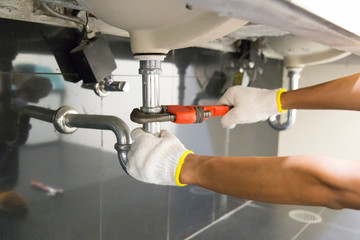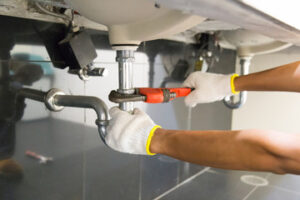Plumbing is a skilled trade that requires knowledge of building codes and regulations, as well as the ability to interpret blueprints. It also requires physical stamina and dexterity. Plumbers must also have good customer service skills and be able to communicate clearly with clients. 
The plumbing industry is crucial to the safety and comfort of our lives. It is essential to regularly maintain drains and sewage systems. Visit https://www.plumbing-express.com/ to learn more.
Plumbing is the system of pipes, fixtures, and appliances that deliver fresh water and remove waste in residential and commercial buildings. It’s essential for everyday life, ensuring clean water supply, efficient waste disposal, and safe heating and cooling. Plumbers specialize in installing, repairing, and maintaining these systems. They also offer services like leak detection and water usage monitoring to improve the efficiency of your plumbing system.
Plumbing systems consist of pipes, valves, and fixtures that connect a building to a public water supply, sewer line, or septic tank. They can also include appliances like sinks, showers, toilets, and dishwashers. Each component plays a vital role in delivering freshwater and removing wastewater. When one of these systems fails, it can cause a wide range of problems, from water damage to health hazards and environmental pollution. To avoid these issues, it’s important to maintain your plumbing system regularly and have any problems fixed promptly.
The earliest plumbing systems developed during ancient civilizations, with the Egyptians and Romans particularly renowned for their advanced water management. Their innovative aqueducts and clay pipes allowed for the transport of freshwater over long distances. More recent developments include copper and PVC pipes, and a variety of appliances that conserve water and reduce energy consumption.
While modern plumbing systems are highly efficient, they still face a number of challenges. Various factors can affect their performance, including corrosion, pressure, and temperature fluctuations. Fortunately, a few simple maintenance tricks can help you keep your plumbing system running smoothly. For example, dripping faucets can often be fixed by replacing worn washers or O-rings. If you have a constant problem with your toilet, it may be due to a faulty flapper valve or fill valve.
Plumbing and piping are similar
Plumbing and piping may look similar, but they have different functions and are subject to different regulations. While both systems transport liquids and gases, plumbing systems are primarily used to provide potable water and sewage removal in buildings. In contrast, piping systems are often used to transport manufacturing chemicals and petrochemicals. This difference is important to understand because it can affect the type of pipe required and the system’s design.
A plumber’s job is to install, repair, and maintain piping and fixtures that convey water in buildings. They are responsible for ensuring that the pipes deliver water at the proper temperature and pressure, and they also ensure that the system meets local building codes and environmental standards. They use a variety of materials, including copper, PVC, CPVC, and PEX, to create piping systems that meet the needs of their clients.
The plumbing system consists of pipes that carry water to and from faucets, toilets, sinks, washing machines, dishwashers, clothes dryers, and other fixtures. The pipes are connected by valves and other fittings that control the flow of water. Plumbing systems must be properly maintained to prevent problems like leaks and clogs.
Plumbing systems are made of a variety of materials, including metals such as copper and brass, and plastics such as PVC and CPVC. These pipes are chosen for their durability and ability to withstand the water pressure and temperature they will encounter. In addition, the pipes can be insulated to help reduce energy costs.
Piping is an essential part of any building, and it must be able to carry liquids, gases, and other materials at high pressures. It is a common part of industrial processes, but it must be constructed of materials that can withstand corrosive chemicals and temperatures. It is also important to ensure that all piping is designed, installed, and maintained according to national standards.
While many of us are familiar with the basic functions of a plumbing system, not everyone knows what goes on behind the scenes to keep our homes and offices functioning properly. The following information will help you better understand the plumbing system in your home and office, so you can identify and fix problems quickly.
Plumbing is a skilled trade
Plumbing is a highly skilled trade that requires a lot of training and technical knowledge. It involves installing, repairing, and maintaining the piping and fixtures in homes and buildings. It also includes laying out piping systems and connecting them to water supply and drainage systems. Plumbers are also trained to troubleshoot issues and repair them using specialized tools. These skills can help you save money and keep your home safe from flooding and other problems.
In addition to learning the fundamentals of plumbing and piping, you should learn about the different tools used in this career, including how to use them safely. This is important because many plumbers work with dangerous chemicals and high-pressure systems that can cause harm if not handled properly.
After completing your training, you will need to pass a licensing exam to become a licensed plumber. This license can be obtained through a vocational school, apprenticeship program, or community college. You should make sure that the program you choose is accredited and offers a quality education. In addition to this, you should find out about the specific licensing requirements in your state or city.
Once you have passed the test, you can start working in the field. You can choose to work for a private company or you can even decide to go into business on your own. This gives you a chance to enjoy more freedom and flexibility, as well as more money. It also helps you maintain a healthier lifestyle by giving you the option to control your schedule and choose your own projects.
Another benefit of the plumbing industry is job security. While other jobs may have a higher risk of layoffs during economic downturns, plumbing and the related industries are expected to grow. This means that plumbers will have plenty of opportunities in the future, and will be able to enjoy a steady income for life.
A career in the plumbing trade can be both challenging and rewarding, depending on how you approach it. It can be very lucrative, but you should know the ins and outs of the field before you make any decisions. This career requires a lot of time and commitment, but it is worth it in the long run.
Plumbing is a career
Plumbing is a rewarding career for those who enjoy a challenge and don’t mind getting dirty. It also pays well and offers great job security. The training is fairly inexpensive compared to other professions and many students find themselves with little student debt upon graduating. Many people also choose this career because they want to start a business rather than working for someone else.
After completing trade school, most plumbers enter into an apprenticeship. These programs are a combination of classroom-based learning and hands-on experience. They will give you the best idea of what it will be like to work in the field once you’re out of school. Typically, these programs last two years or more and will prepare you for full-time employment.
In addition to technical skills, successful plumbers must possess essential soft skills such as communication, problem-solving, and customer service. These skills are critical for building strong relationships with customers and resolving issues quickly and effectively. In addition, they can help you improve your job performance and increase your earnings. You can develop these skills by attending seminars and workshops or through on-the-job training with experienced plumbers.
Plumbing is a gratifying profession because it directly affects people’s lives. It ensures homes and businesses have clean water and a functioning waste system, which is important for health and safety. In addition, it can provide a sense of satisfaction in knowing that you’ve helped a homeowner solve an urgent problem.
Many plumbers have the option to be self-employed, which provides greater flexibility and control over their work schedule and projects. It is also a good choice for those who want to avoid long commutes or don’t want to work in an office setting. In addition, the physical nature of the job can keep you healthy and fit.
Plumbing is one of the most in-demand careers, and there are many benefits to choosing this career. For starters, the required education is relatively inexpensive, and plumbers make above-average salaries. They also have a higher degree of job stability than other professions. Furthermore, the skills that you learn as a plumber are transferable to other careers.



